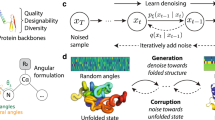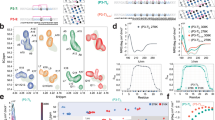Abstract
The structural properties of proteins recovered from random sequence libraries can be used to investigate the relationship between folding and sequence information. Here, we show that helical proteins displaying cooperative thermal denaturation transitions can be easily recovered from a library containing 80-residue proteins predominantly composed of glutamine, leucine, and arginine, with an average hydophobicity level similar to that of natural proteins. The native structure of one of these proteins has a stability and oligomeric form similar to that of many natural proteins but differs in having no slowly exchanging amide hydrogens.
This is a preview of subscription content, access via your institution
Access options
Subscribe to this journal
Receive 12 print issues and online access
$259.00 per year
only $21.58 per issue
Buy this article
- Purchase on SpringerLink
- Instant access to full article PDF
Prices may be subject to local taxes which are calculated during checkout
Similar content being viewed by others
References
Matthews, B.W. Structural and genetic analysis of protein stability. A. Rev. Biochem. 62, 139–160 (1993).
Reidhaar-Olson, J.F. & Sauer, R.T. Combinatorial cassette mutagenesis as a probe of the informational content of protein sequences. Science 241, 53–57 (1988).
Bowie, J.U. & Sauer, R.T. Identifying determinants of folding and activity for a protein of unknown structure. Proc. natn. Acad. Sci. U.S.A. 86, 2152–2156 (1989).
Lim, W.A. & Sauer, R.T. Alternative packing arrangements in the hydrophobic core of λ repressor. Nature 339, 31–36 (1989).
Coplen, L.J., Frieden, R.W. & Goldenberg, D.P. A genetic screen to identify variants of bovine pancreatic trypsin inhibitor with altered folding energetics. Proteins 7, 16–31 (1992).
Kamtekar, S., Schiffer, J.M., Xiong, H., Babik, J.M. & Hecht, M.H. Protein design by binary patterning of polar and nonpolar amino acids. Science 262, 1680–1685 (1993).
Davidson, A.R. & Sauer, R.T. Folded proteins occur frequently in libraries of random amino acid sequences. Proc. natn. Acad. Sci U.S.A. 91, 2146–2150 (1994).
O'Neil, K.T., Hoess, R.H., Raleigh, D.P. & DeGrado, W.F. Thermodynamic genetics of folding of the B1 immunoglbulin-binding domain from streptococcal protein G. Proteins 21, 11–21 (1995).
Uversky, V. Use of fast protein size-exclusion liquid chromatography to study the unfolding of proteins which denature through the molten globule. Biochemistry 32, 13288–13298 (1993).
Privalov, P.L. & Gill, S.J. Stability of protein structure and hydrophobic interaction. Adv. Protein Chem. 39, 191–234 (1988).
Creighton, T.E. Proteins: Structures and Molecular Properties (W. H. Freeman, New York, 1993).
Bai, Y., Milne, J.S., Mayne, L. & Englander, W.S. Protein stability parameters measured by hydrogen exchange. Proteins 20, 4–14 (1994).
Peteranderl, R. & Nelson, H.C.M. Trimerization of the heat shock transcription factor by a triple-stranded a-helical coiled-coil. Biochemistry 31, 12272–12276 (1992).
Lumb, K.J. & Kim, P.S. A buried polar interaction imparts structural uniqueness in a designed heterodimeric coiled coil. Biochemistry 34, 8642–8648 (1995).
Handel, T.M., Williams, S.A. & Degrado, W.F. Metal ion-dependent modulation of the dynamics of a designed protein. Science 261, 879–885 (1993).
Kuwajima, K. The molten globule state as a clue for understanding the folding and cooperativity of globular proteins. Proteins 6, 87–103 (1989).
Ptitsyn, O.B. The molten globule state. in Protein Folding (ed. Creighton, T.E.) 243–300 (W.H. Freeman, New York, 1992).
Filimonov, V.V. et al. Thermodynamic analysis of the chemotactic protein from Escherichia coli, CheY. Biochemistry 32, 12906–12921 (1993).
Hagihara, Y., Tan, Y. & Goto, Y. Comparison of the conformational stability of the molten globule and native states of horse cytochrome c. J. molec. Biol. 237, 336–348 (1994).
Carra, J.H., Anderson, E.A. & Privalov, P.L. Thermodynamics of staphylococcal nuclease denaturation. II. The A-state. Protein Sci. 3, 952–959 (1994).
Hlodan, R. & Pain, R.H. Tumour necrosis factor is in equilibrium with a trimeric molten globule at low pH. FEBS Lett. 343, 256–260 (1994).
Betz, S.F., Raleigh, D.P. & De Grado, W.F. De novo protein design: from molten globules to native-like states. Curr. Opin. struct. Biol. 3, 601–610 (1993).
Tanaka, T., Kuroda, Y., Kimura, H., Kidokoro, S.-i. & Nakamura, H. Cooperative deformation of a de novo designed protein. Prot. Engng. 7, 969–976 (1994).
Finkelstein, A.V. Implications of the random characteristics of protein sequences for their three-dimensional structure. Curr. Opin. struct. Biol. 4, 422–428 (1994).
Oliphant, A.R., Nussbaum, A.L. & Struhl, K. Cloning of random-sequence oligodeoxynucleotides. Gene 44, 177–183 (1986).
Hopp, T.P. et al. A short polypeptide marker sequence useful for recombinant protein identification and purification. Bio/Technology 6, 1204–1210 (1988).
Parsell, D.A. & Sauer, R.T. Induction of a heat shock-like response by unfolded protein in Escherichia coli: dependence on protein level not protein degradation. Genes Dev. 3, 1226–1232 (1989).
Hochuli, E., Dobeli, H. & Schachter, A. New metal chelate adsorbent for proteins and peptides containing neighboring histidine residues. J. Chromatogr. 411, 177–184 (1987).
Laemmli, U.K. Cleavage of structural proteins during the assembly of the head of bacteriophage T4. Nature 227, 680–685 (1970).
Chen, Y.-H., Yang, J.T. & Martinez, H.M. Determination of the secondary structures of proteins by circular dichroism and optical rotatory dispersion. Biochemistry 11, 4120–4131 (1972).
Johnson, M.L. & Frazier, S. Nonlinear least-squares analysis. Meth. Enzym. 117, 301–342 (1985).
Brenstein, R.J. NONLIN for Macintosh (Robelko Software, Carbondale, IL, 1989).
Laue, T.M., Shah, B.D., Ridgeway, T.M. & Pelletier, S.L. Computer-aided interpretation of analytical sedimetation data for proteins. in Analytical Ultracentrifugation in Biochemistry and Polymer Science (eds Harding, S. E., Rowe, A. & Horton, J.) 90–125 (Royal Society of Chemistry, Cambridge, U. K. 1992).
Lee, J.C. & Timasheff, S.N. Partial specific volumes and interactions with solvent components of proteins in guanidine hydrochloride. Biochemistry 13, 257–265 (1974).
Jeng, M.-F. & Englander, W.E. Stable submolecular folding units in a non-compact form of cytochrome c. J. molec. Biol. 221, 1045–1061 (1991).
Author information
Authors and Affiliations
Rights and permissions
About this article
Cite this article
Davidson, A., Lumb, K. & Sauer, R. Cooperatively folded proteins in random sequence libraries. Nat Struct Mol Biol 2, 856–864 (1995). https://doi.org/10.1038/nsb1095-856
Received:
Accepted:
Published:
Issue date:
DOI: https://doi.org/10.1038/nsb1095-856
This article is cited by
-
Protein design under competing conditions for the availability of amino acids
Scientific Reports (2020)
-
An in vitro translation, selection and amplification system for peptide nucleic acids
Nature Chemical Biology (2010)
-
A tale of two symmetrical tails: Structural and functional characteristics of palindromes in proteins
BMC Bioinformatics (2008)
-
Compact and ordered collapse of randomly generated RNA sequences
Nature Structural & Molecular Biology (2005)
-
As simple as can be?
Nature Structural & Molecular Biology (1997)



